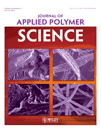A comparison study of lignocellulosic–thermoplastic composites prepared from different compounding techniques
Abstract
A comparison study was carried out to determine the effect of different types of compounding technique, i.e., internal mixer, twin screw extruder, and high speed mixer in the preparation of kenaf-polypropylene composite. The effect of percentage kenaf loading and particle size of kenaf (core) on the flexural properties of the composite was investigated. From the results, the incorporation of kenaf, regardless of particle size had resulted in the reduction of flexural strength of the composite. However, flexural modulus of the composites increased as the percentage of kenaf loading was increased due to the increasing of the stiffness contributed by kenaf fiber. Composites produced from internal mixer had displayed higher flexural properties as compared to those prepared from high speed mixer and twin screw extruder. It was believed that this phenomenon was attributed to the effectiveness of internal mixer with a better compounding mechanism which improved the wetting and distribution on kenaf within the polypropylene matrix. © 2011 Wiley Periodicals, Inc. J Appl Polym Sci, 2011




